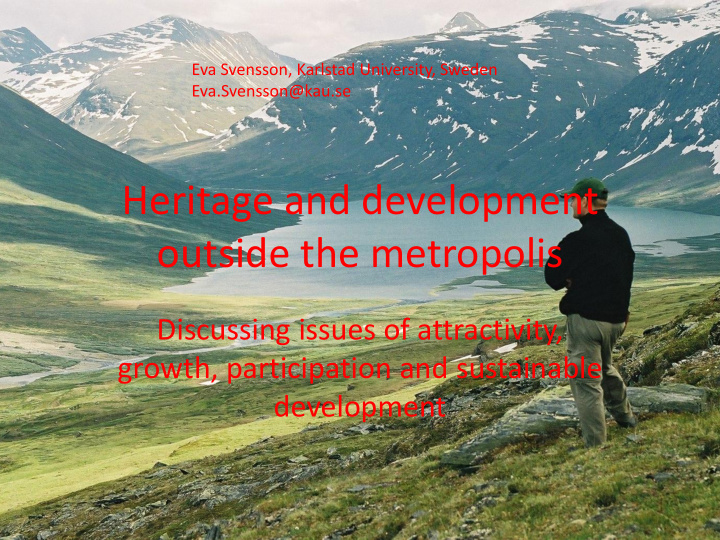



Eva Svensson, Karlstad University, Sweden Eva.Svensson@kau.se Heritage and development outside the metropolis Discussing issues of attractivity, growth, participation and sustainable development
Heritage and nature • Assets for (sustainable) development, especially in rural areas • Contested features, adressed by different groups of actors and different interests • Inbetween conservation and use
Attractivity, Growth & Participation • Attractivity as competition for (the right) inmovers • (Economic) Growth as a ” necessity ” for ” development ” • Citizen participation – for management
A Case - Saxholmen • An island of nature and heritage • A diminishing municipality in search of new (postindustrial) opportunities for development • A legend shared by citizens since childhood
The Legendary Castle • An, from written documents, unknown medieval castle on a rocky island in lake Vänern (the largest lake in Sweden) • Legend of the castle as being burnt down, while the lady of the castle fled with her lover. The legend was recorded in a 17th century book, which has been part of school curriculum in the municipality ever since.
Municipal Ambitions • Municipal 350 years anniversary. Celebration by excavation of the legendary castle • Antiquarian (scientific) guidance and working local volunteers (citizens) • Municipal ambitions: - to create attractivity by offering an interesting history, and a meeting place for citizens - to promote businesses by creating a sight worth seeing
Nature…. • The island was (is) a nature reserve • Conservationists considered the remains of the castle (heritage) a disturbance – and the excavations even worse • Conservationists were overruled by the municipal ambitions • However, conservationists started to take part in the excavations, and the threatened (preserved) spieces started to grow more during the excavations
Citizen Participation • A number of local volunteers took part in the excavations • Volunteers comprised mainly well established persons with strong local reputation • Municipal officers encouraged volunteers to take action for future use of the island for development • Local organisation is created
After Excavation – Development?! • Most volunteers lost intrest after excavations ended • Few citizens were interested in being responsible for developing heritage and nature entreprises or taking part in management • To the volunteering citizens, the main interest was to take part in activities conducted by experts. Achieving authoritative knowledge was a major driving force for participation
Hybridity • Minority of citizens started creating development projects based on nature and heritage, including excavations, on the island • Boat trips and a costume play • Mixing historical knowledge, pre concieved notions and modernity
Lessons …1 • Citizens want to consume knowledge on heritage and history (and possible also nature) • Projects involving expert knowledge seldom survive the exodus of experts • Nature and heritage are considered ” difficult ” and the domains of experts • Nature and heritage are not percieved as assets for building new businesses by most citizens, but as values ” out there ”
Lessons …2 • Attractivity can be created, but is selectively experienced • Participation is not for everybody. Participants must bring in certain qualities or resources • Heritage should be better integrated in the society to contribute to sustainable development. The importance of what heritage can bring in must be elucidated, and the yoke of authenticity must be dealt with • Heritage is a meeting place
Solutions? • Living labs: “…open innovation environments in real-life settings, in which user-driven innovation is fully integrated within the co- creation process of new services, products and societal infrastructures…” • Innovative systems for sustainable development. Heritage is nesting in other sectors of society contributing to meeting places, social capital, alternative consumption etc.
Recommend
More recommend